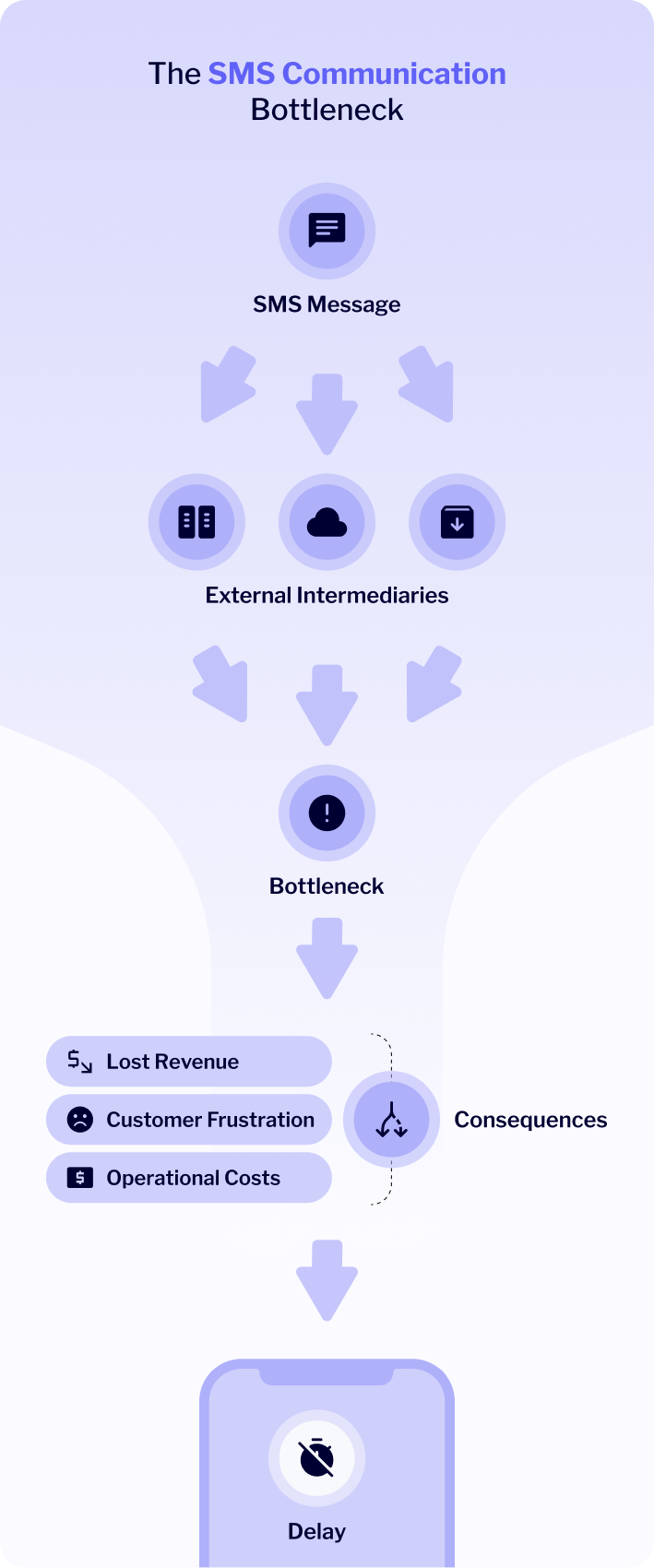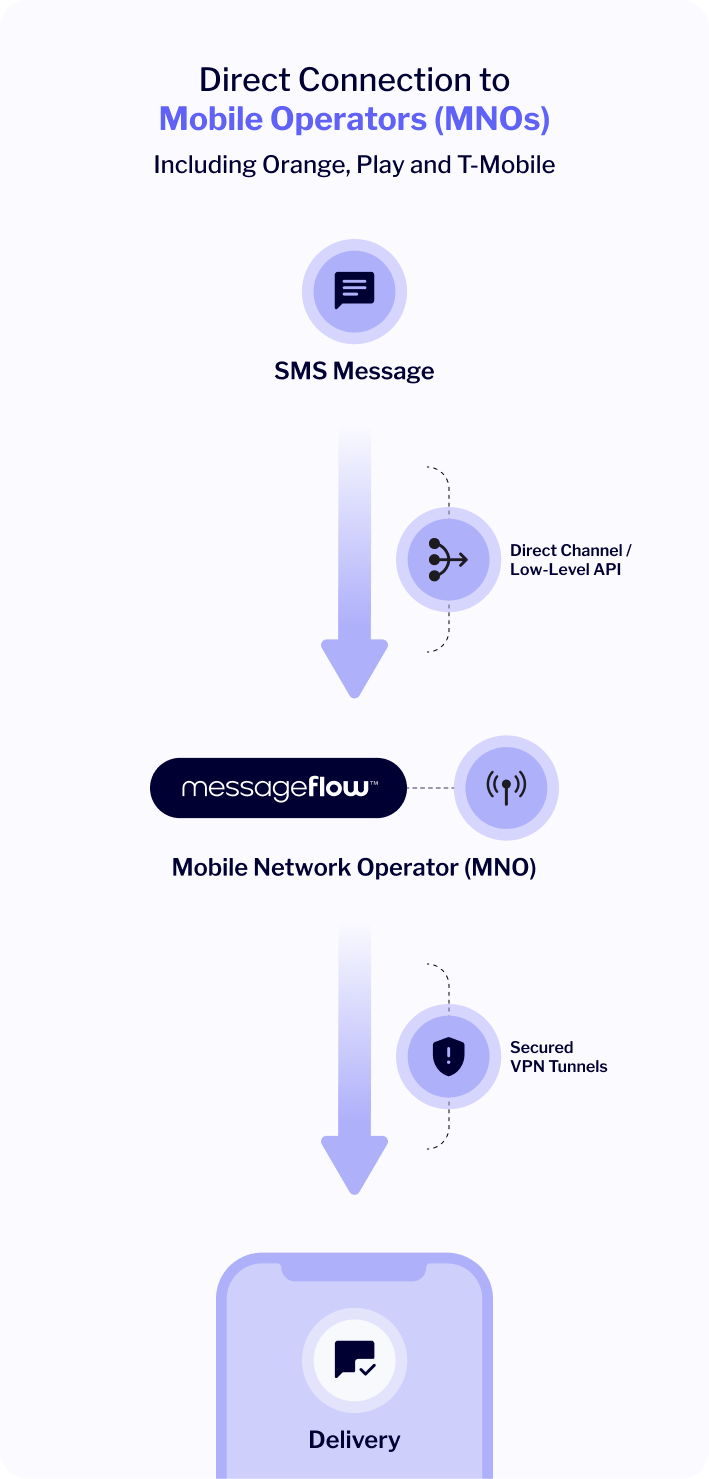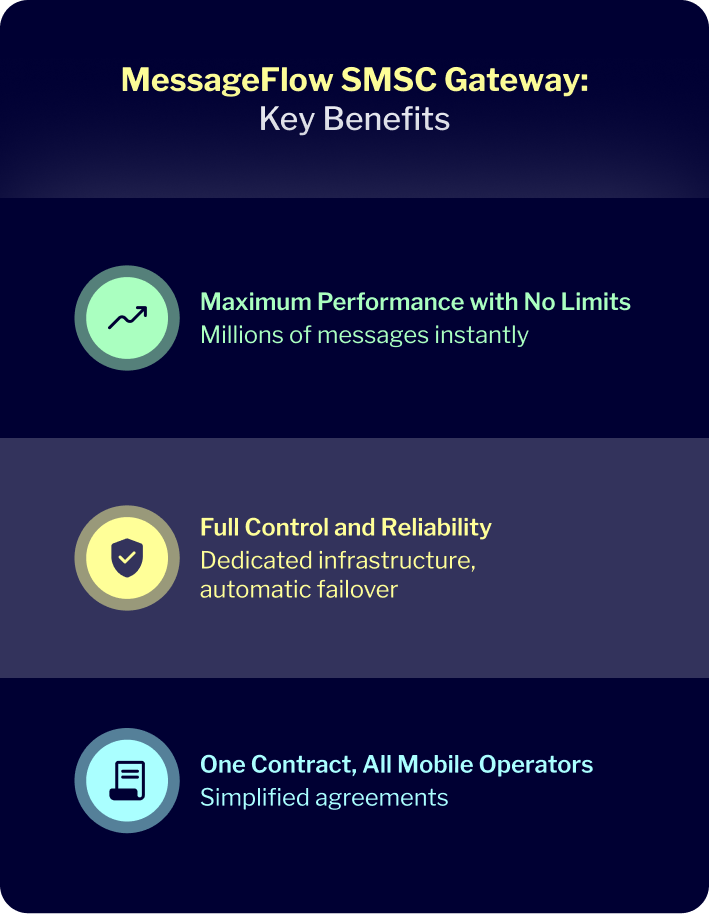In this article, we’ll look at real-world scenarios from different industries to show how a hidden “bottleneck” in SMS communication can impact key business processes. We’ll explain what a dedicated communication channel with mobile operators changes in practice and how you can increase the certainty and predictability of your message delivery.
This is a problem that affects businesses every day, often at the most critical moments.
An authorisation code that arrives too late, making it impossible to finalise a purchase. A delivery status notification that appears after the courier has already left the customer’s doorstep. These seemingly minor incidents are more than just frustrating for the recipient – they lead to real operational costs, lost revenue, and damage to your company’s image.
What is the cause of these delays? Most companies assume that a sent SMS goes straight to the recipient. The reality, however, is often more complicated. Before your message reaches a customer’s phone, it may travel a long way through a network of external intermediaries. Every extra stop on this route is a potential point of delay and failure – and this is the cause of the “bottleneck” in SMS communication.

Scenario 1: The Financial Sector – Security and Trust Measured in Milliseconds
For a financial institution that processes hundreds of thousands or millions of operations every day, SMS communication is the lifeblood of its authorisation processes. At this scale, every point of contact with external intermediaries when sending One-Time Password (OTP) codes is not only a potential delay but also an additional risk to security and business continuity. It’s like a journey with connecting flights – longer, less predictable, and with a greater risk of error. The customer’s session expires, the transaction is blocked, and trust in the institution declines. We know this scenario – it happens in a second, but its consequences can last for hours.
That’s why, in this sector, it’s crucial to have not only sending priority but also your own, fully separate SMS infrastructure with direct connections to operators. Such a model eliminates the entire layer of uncertainty associated with external intermediaries. Messages with OTPs or transaction authorisations reach the customer via the shortest, fully controlled route.
The entire transmission is additionally secured by encrypted VPN tunnels dedicated solely to your messages, which guarantees the confidentiality and integrity of the data at the level required by financial regulations.
The effect?
Your communication becomes independent of external factors, and you gain full control and predictability at the level the financial sector demands. Your customers receive their codes instantly, and your company operates on an infrastructure of the highest reliability.
Scenario 2: Logistics and E-commerce – When Real-Time Information Optimises the Entire Process
Every company in the e-commerce or logistics industry knows this problem: a courier tries to deliver a parcel, but the recipient isn’t home. The automated SMS notification about the planned delivery arrived late or not at all. A delayed message disrupts the flow of the entire supply chain. The result is a costly second delivery attempt, an overloaded customer service department, and, most importantly, a negative shopping experience that damages the store’s image.
The bottleneck in logistics communication works both ways. It’s not just about sending a quick notification about the shipment status but also about instantly receiving a delivery report (DLR). When a message passes through a network of intermediaries, the return report also travels a long way, losing its value in the process. Logistics systems receive outdated data, which prevents them from taking effective action.
The solution is a dedicated communication channel with the mobile operator, which provides access to delivery reports in real time. Such an architecture ensures that information about the message status returns to your systems immediately after it has been processed by the mobile network.
The effect?
Your logistics platform knows exactly when the customer has received a notification and can automatically trigger the next steps in the process. Instead of reacting to problems, you start preventing them, optimising operational costs and building a reputation as a company that always delivers on time – both parcels and information.
Scenario 3: SaaS Platforms – Scalability Under Pressure
Imagine a global SaaS platform that needs to send an immediate alert to hundreds of thousands of users in response to a security incident. In such critical moments, every minute of delay in message delivery means growing risk and declining trust. A similar challenge arises with sudden spikes in popularity – mass registrations and logins generate a wave of Two-Factor Authentication (2FA) codes that can block standard sending channels.
The problem in these situations is not the volume itself, but its sudden and simultaneous nature. An infrastructure based on intermediaries, who handle traffic from multiple clients, often begins to queue messages at such times, leading to unpredictable delays. As a result, security alerts don’t arrive on time, and new users can’t activate their accounts.
That is why platforms for which SMS communication is a critical element of their service need operational certainty and high throughput. This is provided by a dedicated, separate infrastructure, designed for the stable handling of even the largest volumes. This solution allows you to send millions of messages without worrying about queues or slowdowns.
The effect?
You gain full control over your communication and the certainty that your messages will be delivered instantly, regardless of the scale or time of day. Your platform can scale without limits, and users receive key information exactly when they need it, which builds their trust and loyalty.
The Key Difference: Why a Direct Operator Connection Wins
As the scenarios above show, the common denominator for most problems with SMS deliverability and speed is the hidden “bottleneck” – the chain of external intermediaries. Most standard SMS gateways on the market operate based on such a network and do not always have direct agreements with all mobile operators, relying on external partners for part of their traffic.
For organisations for which SMS communication is a pillar of their operations, one thing becomes crucial – complete independence from intermediaries. And this is where the alternative comes in: an architecture based on direct connections with Mobile Network Operators (MNOs).

The answer to this challenge is the MessageFlow SMSC Gateway. It is a service model based entirely on direct technical integrations with mobile operators. Your messages bypass unnecessary intermediate layers, which translates into specific benefits:
- Maximum performance with no limits – Messages sent via a low-level API go directly to the mobile operator’s network, which guarantees minimal delays and a predictable delivery time. You can send millions of messages at peak times without worrying about queuing or slowdowns.
- Full control and reliability – The service runs on a dedicated, separate infrastructure. In the event of a mobile operator failure, traffic is automatically switched to backup channels (a process known as failover), ensuring full business continuity.
- Real-time delivery reports (DLRs) – Gain immediate access to delivery statuses, allowing your systems to react instantly without waiting for delayed feedback from intermediaries.
- One contract instead of many – You get one simple contract that covers sending to all key mobile operators (e.g., T-Mobile, Orange, O2), including ported numbers.
We have intentionally stripped back features that could slow down the service, such as scheduling sends in a panel or link tracking. This is a raw service for conscious customers who know what they need – maximum performance with no compromises. Instead of going through additional application layers, your messages are sent via a low-level API, an interface that communicates directly with mobile operator systems, without unnecessary application layers.
The MessageFlow SMSC Gateway is an Enterprise-class SMS channel, designed for organisations that require maximum speed, scalability, and reliability.

Find Out if Bottlenecks Are Affecting Your SMS Communication
Are you wondering what path your SMS messages actually take? If the challenges described in this article sound familiar, you don’t have to solve them alone.
Our team will be happy to help you analyse your current processes and check whether your communication is free of hidden bottlenecks that could be generating costs and negatively impacting customer experiences. Contact us to discuss your needs and find out how a dedicated SMS channel can support your key business operations.Write to us at or talk to your dedicated Business Advisor.